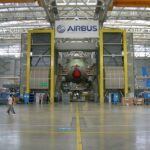
LightspeedHQ on Facebook: An In-depth Data-Driven Analysis – October 2023
October 13, 2023
Harnessing the Power of Digital Marketing in the Manufacturing Industry: A Comprehensive Guide
October 14, 2023Title: Revolutionizing Your Architecture Firm with AI-Driven Manufacturing Optimization: The Future Blueprint
As pioneers in the built environment space, architects are known for envisioning the future. And with technology’s relentless pace, it’s vital for architecture firms to stay ahead of the curve. Our focus today is on an unparalleled digital dimension – revolutionizing architecture firms with AI-Driven Manufacturing Optimization.
Let’s embark on a quest to explore how Artificial Intelligence (AI) is reshaping the architecture industry by enhancing manufacturing optimization, improving efficiency, and stimulating innovative blueprints.
**AI’s Quantum Leap into Architectural Design Manufacturing**
As if borrowed from a sci-fi novel, AI is, in reality, advancing architectural practices by leaps and bounds. Innovative digital tools powered by AI algorithms are assisting architects with efficient design optimization. This has opened a Pandora’s box for greater design accuracy, building resilience, sustainability, and downright architectural brilliance.
Primarily, AI-driven manufacturing optimization revolves around Machine Learning and Deep Learning—the twin pillars of Artificial Intelligence. These concepts are digital dynamos that combine immense data processing power with precision, accuracy, and logic – the very building blocks of avant-garde architectural design manufacturing.
**The Building Blocks: How AI Enhances Architectural Manufacturing Optimization**
Construction projects are complex, time-consuming, and resource-intense, making them ideal for the precise and fast operations of AI. The confluence of AI with IoT (Internet of Things) and BIM (Building Information Modelling) is facilitating efficient design, seamless planning, and agile execution. This integration is driving down project costs, reducing manufacturing errors, and significantly shortening project timelines.
In the light of AI, risk management takes a more proactive approach. Predictive analytics powered by machine learning interpret historical and real-time data to forecast potential risks. By analyzing patterns and trends, architects can preempt issues before they become hindrances to project progress.
**Green Construction: AI’s Sustainability Superpower**
With sustainability at its core, Green Construction is another sphere where AI is making significant strides. AI-powered software is efficient at analyzing various environmental factors, proposing energy-saving solutions and minimizing carbon footprint, leading architects toward sustainable designs.
**The Future of AI in Architecture: A Transformative Blueprint**
As technology continues to disrupt traditional methods, the opportunities for architectural firms to leverage AI are plentiful. From implementing Machine Learning for optimized designs to employing predictive analytics for risk management, and promoting the green construction approach, AI is poised to be a stalwart ally to architects.
Every revolution begins with a vision. It’s time for architectural firms to embrace AI’s transformative potential and craft an optimized future, today.
Adopting AI-driven manufacturing optimization translates into creating sustainable designs, managing risks effectively, and most importantly, staying relevant in a rapidly evolving digital realm. With this, the stage is set for architects to step into the future and invent as they’ve never done before.
In closing, adopting AI manufacturing optimization won’t be a choice but a necessity in navigating the future architectural landscape. And it’s the firms that invite AI into their blueprints that will pioneer the architectural revolution—creating the future, one optimized design at a time.
Title: “The Future Vision: AI-Driven Architectural Innovation Redefining the Global Landscape”
As we delve into the 21st century, the architectural industry is standing on the precipice of a digital revolution powered by Artificial Intelligence. Inspired by ‘Revolutionizing Your Architecture Firm with AI-Driven Manufacturing Optimization,’ let’s muse on the potential future of AI in architecture, painting a picture not just of practical transformations but of far-reaching implications that could redefine our global landscape.
The Next Architectural Epoch: AI-Powered Innovation
Artificial Intelligence is already making waves across industries, and architecture is not immune from this digital tsunami. However, in the architectural space, we’re not just talking improved efficiencies and productivity. AI is poised to redefine the concept of design itself, augmenting human creativity with machine precision to initiate a new era of architectural innovation.
As AI algorithms learn from historical design data, they can propose optimal solutions with speed and accuracy humans cannot match. But as we ascend to the peak of this AI revolution, we could see a leap from reactive AI software to proactive AI architects. These future AI architects could generate designs that pre-empt human needs and environmental demands, evolving from being tools in the hands of architects to becoming architects themselves.
A Whole New World through Environmental Adaptability
A significant area of potential change lies in environmental adaptability. AI’s ability to process enormous data to predict weather patterns, calculate structural stresses, and factor in evolutionary user needs can lead to the creation of buildings that live and breathe with their surroundings. This interweaving of architecture and environment could lead to a future where the line between buildings and landscapes becomes blurred, leading to an unprecedented era of sustainable, harmonious living.
Augmenting the Human Experience
Going beyond structural considerations, AI could redefine the human experience within architectural spaces. Predictive AI and algorithmic personalization could tap into occupants’ unspoken needs to create environments that intuitively adapt to people, offering transformative experiences. Buildings that can modulate lighting, temperature, and acoustics, based on predicted occupant mood, can usher in a future of wellness-centric living.
Ultimately, the possibilities are only limited by our imagination as we move into this brave new world of AI-driven architecture. This journey will be accompanied by ethical considerations and challenges that will need thought leadership. Like any good design, the future of architecture will require balance – in this case, a delicate equilibrium between AI innovation and human sensitivity.
Architecture firms must tune into this digital frequency to thrive in this AI-led future. Thriving in the age of AI will require vision, adaptability, and a relentless focus on human-centric design. The firms that can seamlessly blend AI innovation with human artistry will be the ones shaping the architectural narrative of tomorrows.
As we dwell on the cusp of this AI-driven architectural revolution, one fact becomes clear – the future of architecture will be one where humans and AI don’t just coexist, but co-create a world that truly embodies the spirit of innovation.
SEO Keywords: AI in architecture, AI-driven manufacturing optimization, AI architects, environmental adaptability, predictive AI, algorithmic personalization, wellness-centric living, AI innovation, human-centric design, future of architecture.
“Ready to revolutionize your architecture firm with AI-driven manufacturing optimization? Let’s bring your firm to the cutting edge of technology and efficiency. Click here to get started today!”
Prediction: As we continue to fuse the computational prowess of artificial intelligence with our physical reality, AI-driven manufacturing optimization will greatly revolutionize not just the architecture industry, but all aspects of the built environment. This revolution will empower architects to design and optimize structures with unprecedented precision, efficiency, and environmental sustainability. On-site construction errors will dramatically decrease, and the practice of architecture will transition from a traditionally analog, labor-intensive process to a sophisticated, entirely digitized one, resulting in higher quality, lower costs, and impressive savings in time and resources.
Thought-provoking quote: “As the blueprint of the future, AI-driven manufacturing optimization is not just shaping structures, but carving the path for an avant-garde architecture industry where creativity meets unprecedented efficiency, and where the artistry of design marries the precision of optimized production.”





